Thinking of telling a white lie to save a few quid on your car insurance? We show you how it could end up costing you dearly.

What happens if I lie on my insurance policy?|What could invalidate my policy?|How to get a cheaper policy
What happens if I lie on my insurance policy?
You may think a little white lie never hurt anyone, but giving your car insurer the wrong information can put you at risk of invalidating your policy.
This could prove to be nightmarishly expensive in the event of a claim.
If you get caught, the insurer has the right to cancel the policy or charge the correct premium as a lump sum.
Divers who have had their policy cancelled will then have to declare this on any future applications, and could find it harder and more expensive to get covered.
Insurers can also refuse to pay out for any claim you make which means you could be treated as uninsured.
And depending on the severity of the lie, the driver runs the risk of being blacklisted by all major car insurers.
This could make it virtually impossible for the driver to obtain car insurance from the mainstream providers, and potentially get a cheap premium.

What could invalidate my policy?
A lie in this instance does not have to be a blatant mistruth.
It could mean withholding a piece of information that the insurer would use in calculating the insurance premium or misrepresenting certain details to get a better price.
The most common falsified bits of information are:
Modifications
It’s not worth calling your insurer up if you have brand new seat covers but if you’re modifying your car to add value to it – adding a great big exhaust, for example – you should let your insurer know.
Use of the car
Giving your insurer the wrong information about how you intend to use your car could also get you in trouble.
Insuring your car for “social, domestic and pleasure” use can cut your premium but may not mean you’re insured to drive to work.
Even if you drive to a train station daily before commuting to work, you would still need a “social and commuting” policy as you’re driving on the road in busy commuting hours.
And registering your policy as “social and commuting” only covers you to commute to one place of work.
So, if you’re using your car as part of your job, to drive to other sites as well as your usual place of work, you’ll need to insure it for “Business Class 1”.
For more information, take a look at our guide to classes of use.
Fronting
Some people think it’s acceptable to buy insurance for their son or daughter, listing them as an additional driver as opposed to the main driver.
This strategy is known as “fronting”, which may result in lower premiums but insurers consider it fraud.
The person who drives the car most often should be listed as the main driver on the policy, and additional drivers should only be added if they drive the car occasionally.
Other pieces of information that are worth letting your insurance know about:
- Alterations to the details of other people included on your policy.
- Any increase or changes in the type of mileage you do.
- Minor knocks, as well as more serious accidents, or if you’re not claiming for the accident, you still need to inform your insurer.
- Other incidents, such as fire, theft or water damage – no matter how insignificant you think they are it’s best to let your insurer know.
- Penalty points gained on your licence, or any motor-related convictions. Don’t wait until the renewal, tell your car insurer straight away if you get caught speeding or committing any other crime.
- Changes to your address, or where the car is parked – for example, if you’re a student and your car is registered to your home but it’s actually kept in university halls.
- Changes of career or job title, as this information is used to calculate premiums; your car insurer may ask you to pay extra if you give up the office job for a career in Formula 1.

How to get cheaper car insurance the right way
- Take extra precautions by fitting an alarm and immobiliser.
- Choose a car with a smaller engine.
- Avoid cars with any modifications from the standard manufacturer.
- Take the Pass Plus qualification which could result in a reduction of your premium.
- Opt in for a higher excess – but be sure you can still afford this amount in the event of a claim.
- Consider getting a black box insurance policy if you fall into the high-risk group such as young, inexperienced driver or less frequent driver with a low annual mileage.
- Consider fitting a camera to your dashboard (some insurers offer discounts to drivers with fitted dashboard).
There are certain quirks that you can ignore while driving. These ones, however, need fast attention if you want to stay on the road.
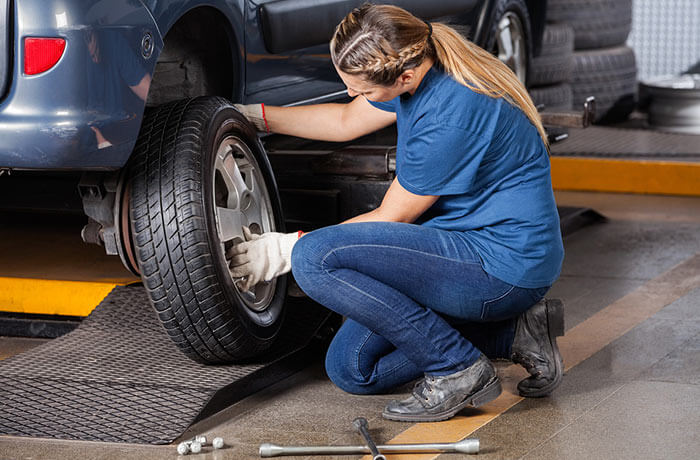
Your car should be serviced regularly according to the manufacturer’s guidelines, usually after a certain time period or mileage.
But if you want to know the warning signs that your car is in dire need of a trip to the garage, look no further than these five symptoms.
1. Engine warning light
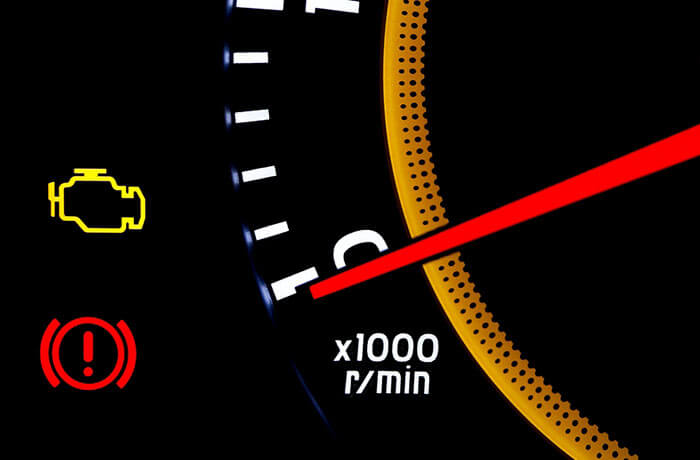
Most modern cars are good at telling you when your car needs to be looked at.
If a yellow “check engine” light appears on your dashboard , you should get your car to the garage for a service as soon as possible as there are a range of engine problems that this light could indicate.
A lot of cars also have a service light that will come on when your next service is due.
While this little light – usually in the shape of a spanner – shouldn’t worry you, it’s best not to ignore it for too long.
2. Strange noises

Any new noises coming from your car should be checked out before they develop into serious problems.
Here are some of the sounds you may hear from your car and what they could mean:
Whining from under the bonnet – Usually caused by a loose belt, which in turn can cause all sorts of issues from overheating to battery problems.
Louder-than-usual exhaust noise – This could be a hole or crack in your exhaust. These tend to be easy to fix but should be looked at because there’s a risk your exhaust pipe could fall off.
Uneven engine noise – You’ll usually hear this when the car is idling. It could mean the engine is misfiring and needs fixing pronto. This could be an easy fix like replacing spark plugs, but could also indicate a more serious problem with your engine and how it handles the air/fuel mixture.
Metal-on-metal – Any scraping sound coming from your car needs to be checked out. This could be a broken part of your car scraping on something else, causing extra damage to both.
Squealing when you step on the brake – This could be an indication of worn brake pads.
Crunching gears – Because the gear box get a lot of wear and tear, fluids and parts often need replacing. If you hear a crunching noise as you change gear, it’s probably time to get your car serviced.
3. Smoke or steam coming from under the bonnet
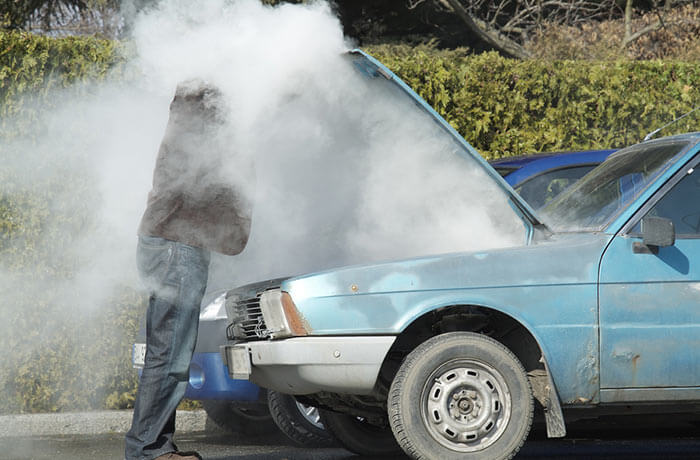
Usually caused by overheating and problems with the radiator, steam is generally white in colour.
While you should get your car checked out ASAP, you’re not in any immediate danger if you do see steam coming from under your bonnet.
Take a look at your car’s temperature gauge. If it’s at maximum, pull over and wait for your car to cool before continuing. When your car is running, the needle should sit in the middle of the gauge.
If you notice blue smoke coming from your car, stop where it’s safe to do so and get someone to tow your car to the garage.
Blue smoke is caused by burning oil, and can be quite a costly problem if left unfixed. Excessive smoke from the exhaust can also signal an oil leak.
This could be caused by a range of problems including:
- piston wear
- worn valve seals
- worn piston rings
- an intake manifold gas leak
- worn engine oil seals
- head gasket failure
4. Vibrating or pulling under braking

This could be due to worn brake discs or pads, a suspension problem or an issue with your steering.
It’s not safe to drive like this so get your car serviced as soon as possible.
These symptoms could also be a sign of tyre wear, so check that your tyres have at least the minimum requirement of tyre tread – 1.6mm – and that they’re not wearing unevenly.
5. Reduced ride comfort
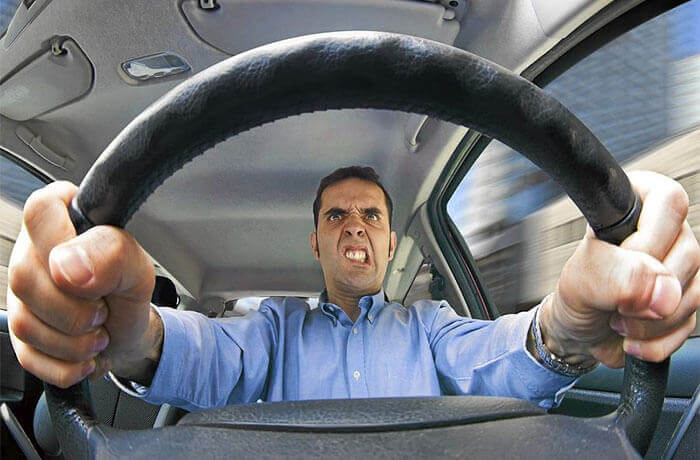
If you find that speed bumps are becoming a problem, your car is riding low or you can hear your tyres scraping on the wheel arch of your car, it’s time to get it checked out.
Any of these symptoms could signal an issue with your suspension.
These are just some of the signs your car needs a service but to keep it in tip-top condition you should follow the manufacturer’s guidelines and get it serviced regularly.
Criminals are increasingly stealing vehicles and passing them off as genuine through a process known as cloning. We explain how to ensure you’re not caught out.
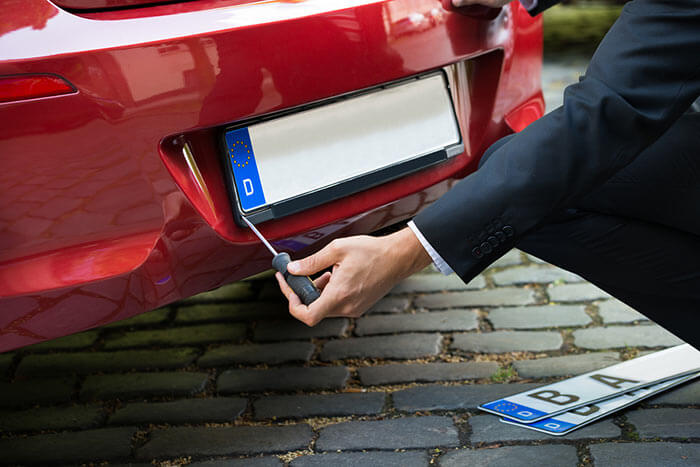
Car buyers are being warned to avoid falling victim to the growing menace of vehicle cloning – a crime that could leave them thousands of pounds out of pocket.
Police in England have recently smashed a national cloning ring which had carried out frauds worth more than £2 million on the south coast and in West Yorkshire.
ID fraud for cars
But although one gang has been brought to justice, experts say that there is evidence that cloning is on the rise in the UK – and buyers should therefore be on their guard.
Cloning involves vehicles being stolen and then effectively being given a new identity.
Criminals disguise the 17-digit Vehicle Identification Number (VIN) on the stolen car and then use a stolen V5 logbook in an attempt to legitimise its identity.
In this way, it is much harder to check that a vehicle up for sale has been acquired illegally.
No chance of money back
If someone buys a cloned car which is later identified as having been stolen, they face having the vehicle returned to its rightful owner with no chance of getting their money back.
Last month, police arrested six people at addresses in Leeds, Bradford and Bournemouth in connection with the theft and cloning of 180 vehicles.
According to West Yorkshire Police, the gang had been operating for almost seven years.
Spokesman Detective Superindendent Pat Twiggs said: “The operation was focused on vehicles being stolen, primarily in the south of England, without keys using specialist equipment.

‘Not just premium cars’
“They were then transported to Leeds where they were professionally cloned using the identities of legitimate vehicles and sold to innocent buyers through used car publications and websites.”
Neil Hodson, deputy managing director for automotive data firm Cap HPI, said: “Police recovered an Aston Martin Vantage worth £38,000 and an Audi Q7 worth £16,000, showing the range of prices and just how much consumers have to lose on buying a clone.
“But it’s not just premium cars that are at risk from cloning: every used car buyer needs to be aware of the very real threat of cloning.”
Do your homework
“Many buyers are just too trusting and buy a car on face value, which could cost them dearly,” he said.
According to HPI , used-car buyers should ensure they view the vehicle at the registered keeper’s address as shown on the V5 logbook.
They should be wary of any vehicle which is being sold at around 70% of the market value or lower, and should also avoid paying by cash if possible.
Cloning to escape prosecution
Finally, buyers should check whether the V5 logbook is genuine – the HPI Check, for example, analyses DVLA records to ensure the logbook has not been recorded as stolen.
Reports suggest that cloned cars are also being used by criminals to avoid prosecution for motoring offences.
In a recent case, a motorist from north London escaped a fine and points on his licence when he was able to prove that a BMW caught speeding in Lincolnshire was not being driven by him and had in fact been cloned.
The motorist’s innocence was demonstrated by anti-fraud firm APU, which used telematics data from the cloned vehicle to show it was still in London when the offence took place.
APU spokesman Neil Thomas said: “It’s very satisfying to help out innocent motorists of course, but the real worry here is that cloning could be back on the rise again.
“It’s usually linked to large-scale organised crime, and it’s hard to stamp out because the clone is registered to the innocent owner’s address, so you have to catch the crooks out on the road.
“However, we believe criminals are increasingly using cloned cars so that innocent drivers shoulder the blame for their inexcusable driving.”
Concern over the contribution made to air pollution by diesel engines has led MPs to propose a ban on the worst offenders in urban areas. Campaigners are also calling for a new diesel sales tax.
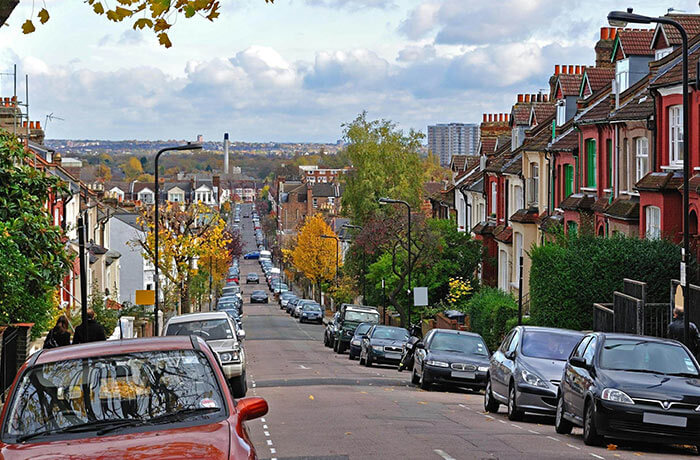
In the House of Commons last month, Geraint Davies, the Labour MP for Swansea, introduced a draft Private Members’ Bill titled Air Quality (Diesel Emissions in Urban Centres).
The proposed Bill calls for diesel vehicles which fail the latest European emission standards to be banned from town and city centres in Britain, as well as an increase in the size of urban pedestrianised areas.
This legislation is supported by the British Lung Foundation, the Royal College of Physicians and the Royal College of Paediatrics and Child Health.
The latter two organisations have recently published research suggesting that around 40,000 deaths a year in the UK are attributable to outdoor air pollution.
Davies said: “The Air Quality Bill will save thousands of lives and billions of pounds every year.
‘Lives under threat’
“Our cities are pumping out belches of diesel clouds which threaten the lives of families, in particular young children and unborn babies.
“The Bill gives local authorities the power to give residents a breath of fresh air by extending low emissions zones, tram systems, pedestrianisation and cycle-lanes, and even to ban the most polluting diesel vehicles from urban centres.”
Davies added that the likes of Volkswagen, which was found by US authorities last year to have cheated on emissions tests, would need to “clean up their acts”.
Davies’ Bill is now scheduled to receive its second reading in the Commons on 22 April after MPs return from the Easter recess.
Scrappage scheme
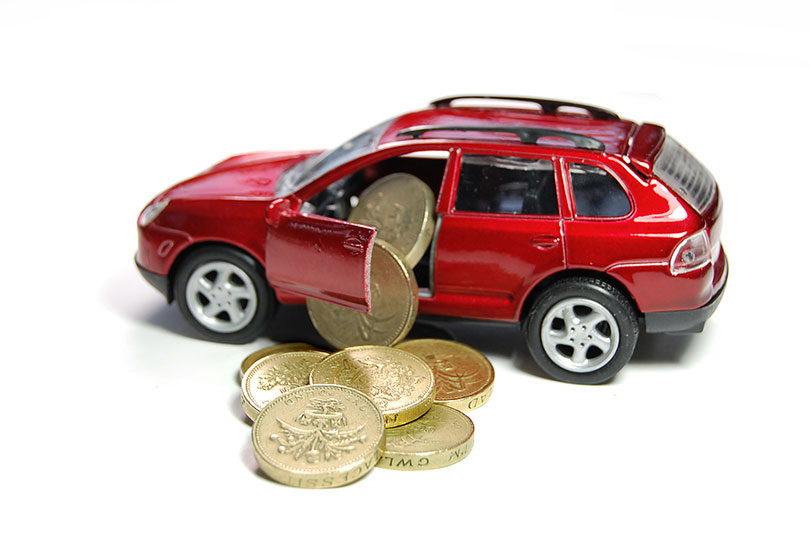
Meanwhile, think-tank Policy Exchange has put forward its own proposals for using higher tax rates to discourage people from buying diesel cars.
The organisation says an £800 levy should be added to every new diesel sale, with the money raised used to fund a scrappage scheme for older vehicles.
Richard Howard, Policy Exchange’s head of environment and energy, said:
“The problem with diesels, as exemplified by the Volkswagen ‘dieselgate’ scandal, is that they perform very badly in terms of local air pollution.”
He added that recent evidence also shows that diesel engines have lost their advantage in terms of CO2 emissions.
£2,000 saving
“Data from the Society of Motor Manufacturers and Traders [SMMT] shows that in 2013, for the first time, CO2 emissions from new petrol cars were lower than emissions from diesel cars, on a sales-weighted basis.”
Under the scrappage scheme put forward by Policy Exchange, motorists who got rid of an old diesel car might be given a government grant of £1,000 with a further £1,000 available from manufacturers.
This would add up to a £2,000 saving on a new vehicle.
The RAC said that, while it recognised the importance of tackling air-quality problems, it remained to be convinced that the proposals put forward by Davies and Policy Exchange would be effective.
“Banning certain diesels from town centres would be hugely disruptive for a vast swathe of motorists and businesses,” said RAC public affairs manager Nicholas Lyes.
“It’s also important to recognise that other forms of transport, including buses, taxis and goods vehicles have a major part to play in reducing emissions.”
Figures from the SMMT show that just under half of all new car sales made in 2015 were diesel models.
However, diesel’s share of the car sales market rose by just 3% last year compared with an 8.4% increase in petrol sales.
Do you think it’s fair to ban diesel cars from city centres? Join in the discussion with our community.
From Friday 16th of August 2013 careless drivers who put other road users at risk by committing offences such as tailgating or poor lane discipline will face on-the-spot fines.
The changes give the police greater flexibility in dealing with less serious careless driving offences, freeing them from expensive and time consuming court processes.
Existing fixed penalty levels for most motoring offences – including using a mobile phone at the wheel and not wearing a seatbelt – rise to £100, bringing them into line with penalties for similar non-motoring fixed penalties.
Road Safety Minister Stephen Hammond said:
“Careless driving puts innocent people’s lives at risk – that is why we have made it easier for the police to tackle problem drivers by allowing them to immediately issue a fixed penalty notice for low level offending rather than taking these offenders to court.”
“We have also increased penalties for a range of driving offences to a level which reflects their seriousness and which will ensure that they are consistent with other similar penalty offences.”
The fixed penalty for careless driving is now £100 with 3 points on the driver’s licence. The most serious examples will continue to go through court, where offenders may face higher penalties.
The police will also be able to offer educational training as an alternative to endorsement. Drivers will still be able to appeal any decision in court.
Fixed penalty levels for most of these motoring offences have not increased since 2000, making them lower than other penalties of a similar severity.
The changes – which were announced earlier this year – are being introduced following extensive public consultation with road safety groups and police forces.
There are no changes to penalty levels for parking offences.
Most motoring fixed penalties offences rise under the changes:
a non-endorsable (where the driver does not receive points on their licence) £30 fixed penalty notice has risen to £50
an endorsable (where points are given) £60 and non-endorsable fixed penalty notice has risen to £100
an endorsable £120 fixed penalty notice has risen to £200
the fixed penalty notice for driving with no insurance has risen from £200 to £300
Graduated fixed penalties (mainly for commercial goods and passenger carrying vehicles and including offences like drivers’ hours and overloading) and financial deposits (for drivers without a satisfactory UK address) have also increased:
a £30 non-endorsable fine has risen to £50
a £60 endorsable and non-endorsable fine has risen to £100
a £120 endorsable and non-endorsable fine has risen to £200
a £200 endorsable and non-endorsable fine has risen to £300
The consultation took place from 14 June 2012 to 5 September 2012.
As with other existing fixed penalty notice offences, such as speeding, police forces are also able to offer careless drivers the option of remedial training.
Endorsable road traffic offences contribute to a significant number of casualties. For example, in 2011, excess speed contributed to 213 deaths and using a mobile phone while driving contributed to 374 road casualties.
Though penalty levels have increase, penalty points will not change. Fixed penalty notices for parking, waiting and obstruction offences remain unchanged.
Endorsement codes and penalty points
Offence codes and penalty points must stay on your driving licence for 4 or 11 years depending on the offence.
Accident offences
These codes must stay on a driving licence for 4 years from the date of the offence.
Code Offence Penalty points
AC10 Failing to stop after an accident 5 to 10
AC20 Failing to give particulars or report an accident within 24 hours 5 to 10
AC30 Undefined accident offences 4 to 9
Disqualified driver
These codes must stay on a driving licence for 4 years from the date of the offence.
Code Offence Penalty points
BA10 Driving while disqualified by order of court 6
BA30 Attempting to drive while disqualified by order of court 6
Careless driving
Codes CD10 to CD30 must stay on a driving licence for 4 years from the date of the offence.
Code Offence Penalty points
CD10 Driving without due care and attention 3 to 9
CD20 Driving without reasonable consideration for other road users 3 to 9
CD30 Driving without due care and attention or without reasonable consideration for other road users 3 to 9
Codes CD40 to CD70 must stay on a driving licence for 11 years from the date of the conviction.
Code Offence Penalty points
CD40 Causing death through careless driving when unfit through drink 3 to 11
CD50 Causing death by careless driving when unfit through drugs 3 to 11
CD60 Causing death by careless driving with alcohol level above the limit 3 to 11
CD70 Causing death by careless driving then failing to supply a specimen for alcohol analysis 3 to 11
Codes CD80 and CD90 must stay on a driving licence for 4 years from the date of the conviction.
Code Offence Penalty points
CD80 Causing death by careless, or inconsiderate, driving 3 to 11
CD90 Causing death by driving: unlicensed, disqualified or uninsured drivers 3 to 11
Construction and use offences
These codes must stay on a driving licence for 4 years from the date of the offence.
Code Offence Penalty points
CU10 Using a vehicle with defective brakes 3
CU20 Causing or likely to cause danger by reason of use of unsuitable vehicle or using a vehicle with parts or accessories (excluding brakes, steering or tyres) in a dangerous condition 3
CU30 Using a vehicle with defective tyre(s) 3
CU40 Using a vehicle with defective steering 3
CU50 Causing or likely to cause danger by reason of load or passengers 3
CU80 Breach of requirements as to control of the vehicle, mobile telephone etc 3
Reckless/dangerous driving
These codes must stay on a driving licence for 4 years from the date of the conviction.
Code Offence Penalty points
DD10 Causing serious injury by dangerous driving 3 to 11
DD40 Dangerous driving 3 to 11
DD60 Manslaughter or culpable homicide while driving a vehicle 3 to 11
DD80 Causing death by dangerous driving 3 to 11
DD90 Furious driving 3 to 9
Drink or drugs
Codes DR10 to DR30 must stay on a driving licence for 11 years from the date of the conviction.
Code Offence Penalty points
DR10 Driving or attempting to drive with alcohol level above limit 3 to 11
DR20 Driving or attempting to drive while unfit through drink 3 to 11
DR30 Driving or attempting to drive then failing to supply a specimen for analysis 3 to 11
DR31 Driving or attempting to drive then refusing to give permission for analysis of a blood sample that was taken without consent due to incapacity 3 to 11
DR61 Refusing to give permission for analysis of a blood sample that was taken without consent due to incapacity in circumstances other than driving or attempting to drive 10
Codes DR40 to DR70 must stay on a driving licence for 4 years from the date of the offence.
Code Offence Penalty points
DR40 In charge of a vehicle while alcohol level above limit 10
DR50 In charge of a vehicle while unfit through drink 10
DR60 Failure to provide a specimen for analysis in circumstances other than driving or attempting to drive 10
DR70 Failing to provide specimen for breath test 4
Code DR80 must stay on a driving licence for 11 years from the date of the conviction.
Code Offence Penalty points
DR80 Driving or attempting to drive when unfit through drugs 3 to 11
Code DR90 must stay on a driving licence for 4 years from the date of the offence.
Code Offence Penalty points
DR90 In charge of a vehicle when unfit through drugs 10
Insurance offences
Code IN10 must stay on a driving licence for 4 years from the date of the offence.
Code Offence Penalty points
IN10 Using a vehicle uninsured against third party risks 6 to 8
Licence offences
These codes must stay on a driving licence for 4 years from the date of the offence.
Code Offence Penalty points
LC20 Driving otherwise than in accordance with a licence 3 to 6
LC30 Driving after making a false declaration about fitness when applying for a licence 3 to 6
LC40 Driving a vehicle having failed to notify a disability 3 to 6
LC50 Driving after a licence has been revoked or refused on medical grounds 3 to 6
Miscellaneous offences
These codes must stay on a driving licence for 4 years from the date of the offence.
Code Offence Penalty points
MS10 Leaving a vehicle in a dangerous position 3
MS20 Unlawful pillion riding 3
MS30 Play street offences 2
MS50 Motor racing on the highway 3 to 11
MS60 Offences not covered by other codes (including offences relating to breach of requirements as to control of vehicle) 3
MS70 Driving with uncorrected defective eyesight 3
MS80 Refusing to submit to an eyesight test 3
MS90 Failure to give information as to identity of driver etc 6
Motorway offences
Code MW10 must stay on a driving licence for 4 years from the date of the offence.
Code Offence Penalty points
MW10 Contravention of special roads regulations (excluding speed limits) 3
Pedestrian crossings
These codes must stay on a driving licence for 4 years from the date of the offence.
Code Offence Penalty points
PC10 Undefined contravention of pedestrian crossing regulations 3
PC20 Contravention of pedestrian crossing regulations with moving vehicle 3
PC30 Contravention of pedestrian crossing regulations with stationary vehicle 3
Speed limits
These codes must stay on a driving licence for 4 years from the date of the offence.
Code Offence Penalty points
SP10 Exceeding goods vehicle speed limits 3 to 6
SP20 Exceeding speed limit for type of vehicle (excluding goods or passenger vehicles) 3 to 6
SP30 Exceeding statutory speed limit on a public road 3 to 6
SP40 Exceeding passenger vehicle speed limit 3 to 6
SP50 Exceeding speed limit on a motorway 3 to 6
Traffic direction and signs
These codes must stay on a driving licence for 4 years from the date of the offence.
Code Offence Penalty points
TS10 Failing to comply with traffic light signals 3
TS20 Failing to comply with double white lines 3
TS30 Failing to comply with ‘stop’ sign 3
TS40 Failing to comply with direction of a constable/warden 3
TS50 Failing to comply with traffic sign (excluding ‘stop’ signs, traffic lights or double white lines) 3
TS60 Failing to comply with a school crossing patrol sign 3
TS70 Undefined failure to comply with a traffic direction sign 3
Special code
Code TT99 must stay on a driving licence for 4 years from the date of conviction.
It shows disqualification under ‘totting-up’ – if the total of penalty points reaches 12 or more within 3 years, the driver can be disqualified.
Theft or unauthorised taking
Code UT50 must stay on a driving licence for 4 years from the date of the offence.
Code Offence Penalty points
UT50 Aggravated taking of a vehicle 3 to 11
‘Mutual recognition’ codes
You’ll get an ‘MR’ code on your licence if you’re disqualified while driving in Northern Ireland, Isle of Man or the Republic of Ireland. Your disqualification period will also be valid in GB and will stay on your licence for 4 years from the date of conviction.
Code Offence
MR09 Reckless or dangerous driving (whether or not resulting in death, injury or serious risk)
MR19 Wilful failure to carry out the obligation placed on driver after being involved in a road accident (hit or run)
MR29 Driving a vehicle while under the influence of alcohol or other substance affecting or diminishing the mental and physical abilities of a driver
MR39 Driving a vehicle faster than the permitted speed
MR49 Driving a vehicle whilst disqualified
MR59 Other conduct constituting an offence for which a driving disqualification has been imposed by the State of Offence